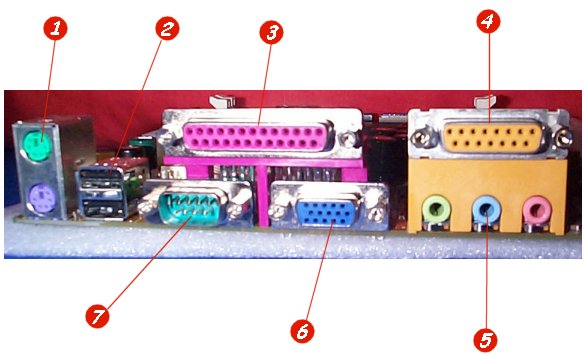
Understanding you Motherboard - External
The motherboard also has external connectors for devices such as keyboards mice and printers. We will take a quick look at these connectors and show which is which. Although it is difficult to plug pieces in the incorrect slot due to there shape and size differences, it helps to have the knowledge of what you are doing rather than just finding the one that fits. Again you can click on the numbers on the image to take you to the section you require.

ATX boards have 2 PS/2 connectors, one for the mouse and one for the keyboard. They are the same size the same shape but a different colour. This is because the Mouse and keyboard connectors are not interchangeable. Plugging the keyboard in to the mouse connector and vice versa will make them both useless. The usual way for these to be plugged in is the mouse into the Green connector and the keyboard into the purple connector.
2 - USB (Universal Serial Bus) Ports
USB is getting more and more popular for external components. So much so that you can even buy external USB hard disks now. The big hype about USB as that you can change the devices on the USB without switching the power off the computer. If you have a mouse and a Scanner plugged into USB for example, and you wanted to play your new game on your USB controller, you could unplug your Scanner and plug in your game controller. The system would then recognise the change and let you use the controller straight away. You will normally get 2 USB ports with an option to add an extra 2 via a cable.
The parallel port is mainly used for scanners and printers, and is associated with LPT1. Parallel ports send data in parallel i.e. more than one bit at a time. If the channel is 8bits wide then a parallel port would send 8 bits at a time.
The Game port is really just a serial port normally found on a sound card. as the picture above has onboard sound in order to show you everything an ATX motherboard can have on it, the game port is above the sound connectors. Gamepads and joysticks plug into the game port. The game port is a female connector and larger than that of the standard COM port.
The Sound card that is built into the board has three connectors, these are Speaker out, this is your main output for your computer speakers, depending on your sound chip you may or may not need powered speakers. Check with the motherboard manual for this. Then you will have the Line in, Line in is for external sources of audio that you want to hear through your computer or possibly record, i.e. from your Hi-Fi. The last of the 3 is the Mic in port. This is for the Microphone. The Microphone can again be used to add sound to recording or just to play through your speakers as a karaoke system.
This motherboard also has onboard graphics, if this is the case with your motherboard then you will have this connector on your motherboard. The Display connector is also female (meaning the pins will be on the end of the monitor cable.) If you have a standard graphics card then this connector will be on the back of your graphics card.
The COM port is used for peripherals such as mice and modems, becoming less popular now though as USB and PS/2 have taken over. Motherboards seem to only have the 1 COM port now in favour of more USB ports.